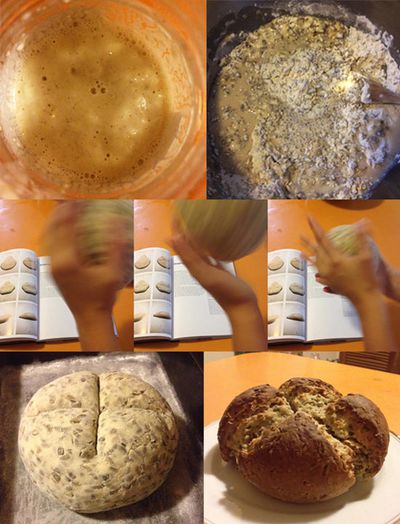I first learnt how to make a very basic bread a few years ago while living in a rickety Queenslander where if you kneaded the dough with too much vigour the floorboards would shake. Since then, bread has become one my favourite things to make in a kitchen, though I can’t say I’ve ever progressed past novice stage. My ‘bread’ still frequently suffers from an alarming similarity to cakes, though I do think I make pretty good pizza dough. This year I’m planning to finally advance to ‘intermediate’ with the help of Dan Lepard’s The Handmade Loaf.
This book brings together a collection of recipes, personal stories and photographs that capture the breads and home bakers of Europe. The blurb describes the book as suitable for ‘a generation ready to discover the simple pleasure of baking their first crisp loaf at home’ and flicking through the pages, I noted the instructions seemed clear and easy-to-follow, with photographs illustrating the steps. (Lepard is a photographer, as well as baker and food writer, and this is immediately evident in the feel of the book.) With this encouraging beginning I set out to create my own leaven.
The ‘science experiment’ element is probably my favourite thing about the whole process of bread making - the way you feed the leaven and allow it to ferment, swelling up into frothy bubbles. I grew fonder and fonder of this acidic smelling mess as I fed it each day, feeling almost like I had a strange pet living in the kitchen, less a dog and more a sea monkey. I am led to believe this is a common experience given most other home bakers I know have names for their own leavens such as ‘Bruce’ or ‘Susan’.

The leaven was ready six days later and I arrived home from work at about 6pm eager to bake my first crisp home loaf. Unfortunately the recipe I’d originally decided to go with was an all-day commitment, starting at 8am and accordingly, I learnt my first crucial lesson of baking bread: Prep work really does matters. Determined to continue despite this, I quickly moved past the slow bread chapter (‘The Natural Leaven’) and onto ‘Seeds and Grains’ where I discovered a recipe for sunflower bread described as, “a very simple quick loaf to make, jam-packed with toasted sunflower seeds and with a slight taste of honey”. Perfect, I thought, and immediately set to work.
Lepard’s approach to baking is deeply thought-out and well-researched. He offers explanations for all his decisions, some of which are opposite to everything I’ve learned in the past such as kneading the bread at long intervals for a mere 10 seconds. There are no ‘cup’ measurements but instead, metric weights and percentages, and he also uses fresh yeast as opposed to the dry one I usually use. It’s definitely worth reading all the introductory sections and cook’s notes as it will set you in the right frame of mind to approach the recipes. Also, I actually found it exciting to learn so much about bread, about the historical context of recipes and different techniques, not to mention the ongoing debates between bakers.
The sunflower bread recipe was very straightforward and I seemingly had no trouble following it, though given my imprecise scales, a temperamental oven and no thermometer, I did a bit of guesswork with aspects of the recipe. (Second crucial lesson of baking bread: Invest in key pieces of equipment that function.) Also, and this is my own terrible baking secret, I tend to be a little impatient. When my dough hadn’t risen within the recommended two and a half hours I popped it in the oven anyway (oh no, I hear the cries of experienced bakers) to mixed results. The next day I persuaded my workmates and housemates to taste the bread - which looked vaguely like an exploded hot cross bun - and responses varied from ‘like a cake given to someone as a punishment’ to ‘a bit raw inside’. With this, I fed the remaining loaf to our chickens and tried to accept crucial lesson number three: Always, always be patient.
Despite this setback, I honestly can’t wait to try a new recipe. And by the year’s end I’ve no doubt that I will have made it to Beginner/Intermediate - at least!


